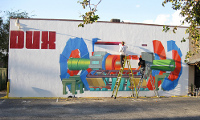 |
 |
|||||||||||||
|
|||||||||||||
|
|||||||||||||
|
Some 400 pages of calculations, simulations, detector descriptions, estimates, some 1000 signatories from all round the world, hours spent on the phone or clustered around conference tables – a lot of hard work and careful thinking went into the Letters of Intent (LOI). Each of the three submitted letters – for ILD, for SiD and for the 4th concept or 4th for short – managed to meet the deadline, and even though they didn’t manage to stick to the recommended page limit of 100, they were all accepted and are being scrutinised by the international detector advisory group IDAG (see this week’s other feature). This is a story about how an LOI is written, as told by the authors and editors.
A multi-page LOI about a multitude of different subdetectors, simulation studies, hardware options and technologies is always the work of many people. However, a consistent document can only be pulled together efficiently by a small team. Phil Burrows was part of the team for SiD, Ties Behnke for ILD and John Hauptman for 4th. They have all worked on similar publications before – the detector outline documents, the Reference Design Report, the TESLA TDR or the 'Gateway to the Quantum Universe' brochure, to name just a few. But every report is different and special, and in the end it's down to editing night shifts and last-minute corrections. “I feared that people would be late in providing text and materials and that the editors would end up in a last-minute flap trying to pull it all together,” says Phil Burrows. “Those worries were fully justified!” John Hauptman adds: “Parts were written early but, like a Bragg curve, the greatest energy loss was at the end of the range.” The writing itself is not done by the editors – at least not by the editors alone. Each area has a smaller group of people who lead the effort and submit the text. “For ILD, I would say that in total around 50 people made contributions to the LOI in one form or another,” calculates Ties Behnke. “The LOI was the first report which ILD as a group wrote, and the first report where there was a very close collaboration between the Asian, the European and the American ILD community.” ILD, the International Large Detector, is the largest of the three concepts. It is a product of two former concepts, GLD and LDC. The two communities had to get to know each other, define the details of their planned detector and then start the benchmarking process. They had to integrate the many different technological solutions which cannot all become a "baseline". “People were very cooperative in trying to find working solutions,” says Behnke. Versions were then posted on the web, all collaborators were able to download it, make comments, upload a new version, always strictly monitored by the editors. That process worked well for all concepts, but as always the devil was in the details. SiD, for example, encountered a consistency problem nobody expected. “We provided a simple www template for authors to sign up, but the format of the information required was not specified tightly enough and we had all variants of possible name styles for people, institutes and addresses,” explains Burrows. “The editors went through by hand harmonising all the name styles; we even had to google addresses of a number of institutes.” As exhausting as the process may have been, all three concepts are happy and proud to have done it and delivered on time. The effort pulled the communities together, forced groups to think about organisation of work and the layout of the detectors. “You are no longer able to put aside, or actually forget about, certain problems with the design that you don't really want to face,” says John Hauptman. “It's therapeutic.” All three would do it again – though maybe not right away because they are all looking forward to spending more time designing, building and testing their detectors. Hauptman concludes: “Of course we would do it again, since we like this detector, we're proud of it, and it's all ours. It's somewhat like creating a painting, or an epic poem, especially for the students who make wonders happen starting only with their own wits.” -- Barbara Warmbein |
|||||||||||||
| © International Linear Collider |
